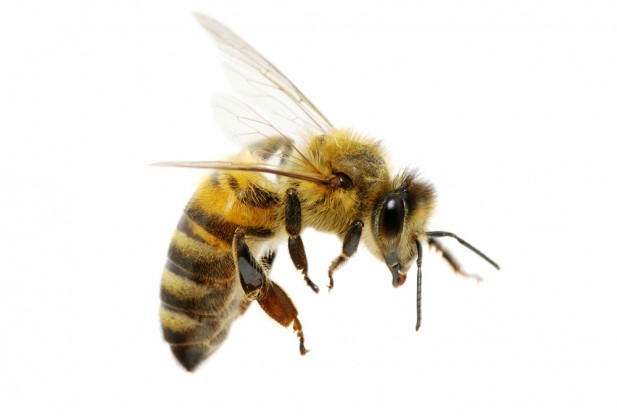You may have noticed something over the last several years worth of summers – a certain lack of buzz as the weather gets warmer and flowers begin to bloom. If you take honey in your tea, you may have felt that deafening silence at the grocery, where the price of honey has been steadily increasing at a rate of almost 10% per year. If you keep a home garden, you might have found that some flowers aren’t bearing fruit like they used to. And if you are a commercial farmer, or work in agriculture, then you will have definitely noticed the rising difficulty – and cost – of properly pollinating fields. Honey bees are disappearing. Even more troublingly, no one seems to have a clear answer as to why.
To the casual apiologist (that would be someone who studies honey bees), the sudden disappearance of bees may not seem like a big deal. Winnie the Pooh might have a harder time finding honey to fill his tummy, and a generation of children may grow up without learning a painful lesson about not jumping through flower beds, but so what? Most of us hardly ever think of bees except when one happens to fly into our car and full on panic ensues. In fact, given that a small but not insignificant number of car accidents occur precisely due to bees, this could even be a good thing, right? Less bees mean less stings!
Bee Concerned
Unfortunately, the world is a complicated and interconnected place, and bees may well just be at the center of it. In fact, for most people in Europe and the Americas, honey bees are responsible for every third bite of food you eat. In the US alone, in 2000, the estimated value of crops that rely on honey bees entirely for pollination was estimated to be over $15 billion USD. Honey bees bring in more revenue than Starbucks, and while the latter seems to be sprouting new stores faster than you can say “grande half-caf no-cal caramel apple macchiato with extra caramel”, the bees are vanishing at an alarming rate. Some beekeepers are reporting losses of as high as 90% of their colonies seemingly overnight.
To understand why honey bees are so important and how they can account for so much pollination despite being notoriously bad at pollination (honey bees are some of the least efficient pollinators in the animal kingdom, second perhaps only to Chinese farmers who often pollinate apple trees by hand with special brushes and buckets of pollen), you have to look at the state of modern agriculture. As the global population has grown, feeding all 7+ billion people has become increasingly difficult. This gave rise to factory farming and a reliance on a few key staples. Unfortunately, many of these plants aren’t native to many of the places where they are grown, and native pollinators just aren’t interested. Even when native species match up, the high concentration of crops that is the hallmark of industrial farming often relies on a high concentration of pollinators during certain seasons – concentrations far higher than can be provided naturally.
Enter modern beekeeping. If your mental image of beekeeping is like most, you’re probably picturing scenes of an idyllic countryside wildflower meadow, perhaps with a few quaint wooden beehives set up here and there. You couldn’t be further from the reality. Instead, imagine an 18-wheeler with an extended trailer loaded to the top with state of the art beehives driving down the highway. That’s the reality of the modern beekeeper. The need for high concentrations of pollinators have given rise to mobile apiarists who pack up their bees and take the show on the road. Not only does this allow the bees to bee (sorry, we couldn’t help ourselves) where they’re most needed when they’re most needed, it helps the beekeepers avoid cold weather that makes bees become dormant, and helps increase honey production year round. Without this mobility, many important crops like soybeans, okra, sunflower, and tomatoes simply couldn’t be grown at the scale demanded by consumers. And these rolling bee-mobiles are suffering some of the worst losses of all.
Where Have All the Bees Gone?
The culprit behind this troubling development is an affliction called Colony Collapse Disorder (CCD), though it has often gone by more colorful names including disappearing disease, spring dwindle, and autumn collapse. CCD is one of those vague, blanket terms scientists make up when they have no idea what’s going on but need something to call it. It’s characterized by bee hives that seem like they should be doing fine – honey and pollen stocked up for feeding, the queen bee is alive and well, young bees growing in capped chambers in the wax – yet inexplicably fail due to all the adult worker bees simply vanishing. Imagine if suddenly, every adult in the United States simply disappeared, except for the president. That’s CCD.
Despite numerous working groups, scientific panels, countless man-hours of research, and millions of dollars in funding, no one seems to be able to point to a root cause of CCD. Likely culprits have included pesticides (specifically the new strains of what are called neonicotinoids), pests such as Varroa mites and the Nosema fungus, a rise in infectious diseases that target honey bees, and even outlandish and off-the-wall theories that include everything from electromagnetic radiation, radio waves, and wind turbines. All of these have been largely ruled out as the primary cause of colony collapses. Instead, more and more researchers believe that all of these causes and others combine to form a perfect storm – pesticides may weaken the immune systems of bees enough that mites and other parasites manage to get a foothold, which then requires beekeepers to spray anti-parasite compounds in their hives, which further decreases bee immune systems and leaves them vulnerable to viruses and infections. All in all, the research is nothing if not muddled. Governments, desperate to stop or at least slow down CCD, have taken steps that range from banning certain classes of pesticides, as in France, to implementing extensive tracking and research projects. So far, little has seemed to work.
So what does the future of food look like if the problem of the vanishing bees isn’t addressed? The good news is that the most important staple food crops like corn, wheat, rice, and potatoes don’t rely on honey bees for pollination. The bad news is that many of the “luxury crops” we have grown to love do. From cucumbers to kiwi fruit, cauliflower to cherries, many of our favorites need a large bee population in order to bear fruit. In some places, like China, the lack of pollinators has given rise to brigades of low-wage workers who go into fields and orchards and pollinate plants by hand – a very costly and time-intensive process. In others, some crops that were once the mainstay of local economies have become non-viable and had to be abandoned entirely. If the bees disappear, we may not starve, but we will be left with significantly less biodiversity, and our dinner plates will start to resemble those of subsistence farmers more and more. Whether you are a farmer or a foodie, the disappearing disease spells a food future that is radically different from what we enjoy now, and that’s reason for everyone to become concerned.





